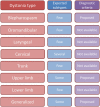How Many Dystonias? Clinical Evidence
- PMID: 28217105
- PMCID: PMC5289979
- DOI: 10.3389/fneur.2017.00018
How Many Dystonias? Clinical Evidence
Abstract
Literary reports on dystonia date back to post-Medieval times. Medical reports are instead more recent. We review here the early descriptions and the historical establishment of a consensus on the clinical phenomenology and the diagnostic features of dystonia syndromes. Lumping and splitting exercises have characterized this area of knowledge, and it remains largely unclear how many dystonia types we are to count. This review describes the history leading to recognize that focal dystonia syndromes are a coherent clinical set encompassing cranial dystonia (including blepharospasm), oromandibular dystonia, spasmodic torticollis, truncal dystonia, writer's cramp, and other occupational dystonias. Papers describing features of dystonia and diagnostic criteria are critically analyzed and put into historical perspective. Issues and inconsistencies in this lumping effort are discussed, and the currently unmet needs are critically reviewed.
Keywords: definition and concepts; dystonia; history; movement disorders; phenomenology.
Figures


References
-
- Alighieri D, Ciardi J. The Inferno (English Translation). New York: Signet Classics; (2009).
-
- Tulpius N. Observationes Medicae. Amsterdam: Danielem Elzevirium; (1672).
-
- Heister L. Chirurgie, In welcher alles, was zur Wund-Artzney gehört, Nach der neuesten und besten Art, gründlich abgehandelt, und In vielen Kupffer-Tafeln die neu-erfundene und dienlichste Instrumenten, Nebst den bequemsten Handgriffen der Chirurgischen Operationen und Bandagen vorgestellet werden. Nürnberg: Johann Hoffmanns seel Erben; (1731).
-
- Reichel G. Cervical dystonia: a new phenomenological classification for botulinum toxin therapy. Basal Ganglia (2011) 1:5–12. 10.1016/j.baga.2011.01.001 - DOI
Publication types
LinkOut - more resources
Full Text Sources
Other Literature Sources

